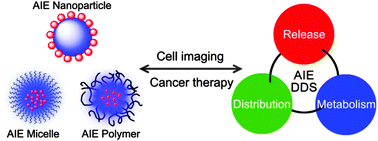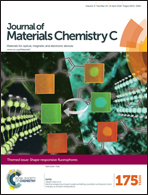Subcellular behaviour evaluation of nanopharmaceuticals with aggregation-induced emission molecules
Abstract
Nanopharmaceuticals possess a myriad of advantages for disease treatment, not only in delivering therapeutic agents, but also in deciphering their innate intracellular or subcellular behaviours, providing detailed diagnostic and prognostic information, quantifying treatment efficacy and designing better therapeutics. To evaluate the subcellular behaviour of nanopharmaceuticals, colourful fluorescence is the most potential technique, because it is capable of painting the subcellular detail in three dimensions with high resolution. Furthermore, the fluorescence is switchable, and thus the subcellular details can be lightened specifically without the undesirable background. However, most nanopharmaceuticals lack a fluorescent report group, and its introduction requires extra steps. Moreover, the introduced fluorescent groups can suffer from concentration quenching or aggregation-caused quenching (ACQ) when they are embedded in nanopharmaceuticals at a high concentration. The unique aggregation-induced emission (AIE) effect provides a straightforward solution. The aromatic cores of AIE molecules are always hydrophobic and do not undergo the ACQ effect even at high concentrations. Hence, AIE molecules can be directly introduced as building blocks to provide the driving force for the self-assembly of nanopharmaceuticals and can allow us to develop label-free, ACQ-free and luminescent nanopharmaceuticals that can simultaneously implement drug delivery and subcellular behaviour evaluation. This review presents different types of AIE molecules-based nanopharmaceuticals and their biological properties and applications for imaging subcellular behaviours, including the drug releasing process, metabolism of nanopharmaceuticals, subcellular distributions of drug and carriers, and therapeutic effect. With detailed acquaintance of these subcellular behaviours, we anticipate that the research we discuss in this review can inspire other scientists to develop next generation nanopharmaceuticals that can be guided by fluorescence imaging and thus can realize concisely controllable drug delivery.

- This article is part of the themed collection: Shape-Responsive Fluorophores

 Please wait while we load your content...
Please wait while we load your content...